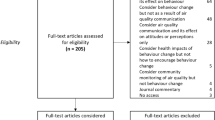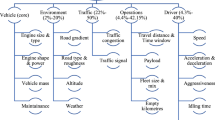Abstract
The importance of perception response time (PRT) values for traffic signal change interval design, and the need to monitor the design PRT value, are challenges facing transportation professionals. However, current methods used to validate the design PRT value from on-site observational studies have failed to yield convincing proof that the 1 second design value is adequate. A modification to on-site data capture and extraction, using a transitional zone (TZ), is used to overcome this deficiency. The TZ allows the systematic identification and exclusion of those drivers who have time to delay their responses. Their inclusion in past studies inflated PRT values. Their exclusion in this study provides a more accurate value.








Similar content being viewed by others
References
Arasan VT, Rao DM. Estimation of intergreen interval for maximum safety at traffic signals. Proceedings of the International Conference on Transportation into the Next Millennium; 1998 Sep 9-11; Singapore. Singapore: Nanyang Technological University, 1998
Mahalel D, Zaidel D. A probabilistic approach for determining the change interval. Transport Res Rec 1986; 1069: 39–45
Wortman RH, Matthias JS. Evaluation of driver behavior at signalized intersections. Transport Res Rec 1983; 904: 10–21
Parsonson PS, Czech WS, Bansley WC. Yellow and red clearance signal timing: drivers and attorneys speak out. ITE J 1993; 63: 26–31
Indiana County’s intersection design may be negligent even when it conformed to engineering standards [online]. Road Inj Prev Litigation J. Available from URL: http://www.usroads.com/journals/p/rilj/9802/ri980201.htm [Accessed 2001 Dec 30]
Naylor DW, Graham JR. Intersection design and decision-reaction time for older drivers. Transport Res Rec 1997; 1573: 68–71
Shasheen SA, Niemeier DA. Integrating vehicle design and human factors: minimising elderly driving constraints. Transport Res Part C 2001; 9: 155–74
Sanders MS, McCormick EJ. Human factors in engineering and design. Singapore: McGraw-Hill Inc., 1993
Department of the Environment, Transport and the Regions. Tomorrow’s roads: safer for everyone. London: Department of the Environment, Transport and the Regions, 2000
Department of Transportation. Safety in numbers: using statistics to make the transportation system safer. Washington, DC: Bureau of Transportation Statistics, Department of Transportation Safety Council, 2000
Taoka GT. Brake reaction times of unalerted drivers. ITE J 1989; 59: 19–21
Olson PL. Forensic aspects of driver perception and response. Tucson (AZ): Lawyers and Judges Publishing Company Inc., 1996
Institute of Transportation Engineers. Traffic engineering handbook. Washington, DC: Institute of Transportation Engineers, 1999
Hooper KG, McGee HW. Driver perception-reaction time: are revisions to current specification values in order? Transport Res Rec 1983; 904: 93–7
Johansson G, Rumar K. Driver’s brake reaction times. Hum Factors 1971; 13(1): 23–7
Massachusetts Institute of Technology. Report on Massachusetts highway accident survey, CWA-ERA project. Cambridge (MA): Massachusetts Institute of Technology, 1934
Gazis D, Herman K, Maradudin A. The problem of the amber signal in traffic flow. Operations Res 1960; 8: 112–32
Olson PL, Rothery RW. Driver response to the amber phase of traffic signals. Operations Res 1961; 9: 650–63
Chang MS, Messer CJ, Santiago AJ. Timing traffic signal change intervals based on driver behavior. Transport Res Rec 1985; 1027: 20–30
Wortman RH, Witkowski JM, Fox TC. Traffic characteristics during signal change intervals. Transport Res Rec 1985; 1027: 4–6
Ranney TA. Models of driving behaviour: a review of their evolution. Accid Anal Prev 1994; 26: 733–50
Wong YD, Goh PK. Driver perception-response time for braking action during signal change interval. Road Transport Res 2000; 9: 17–26
Wong YD, Goh PK. Perception-braking response time of unalerted drivers at signalised intersections. ITE J 2001; 71: 73–6
Ang A, Tang WH. Probability concepts in engineering planning and design. New York: J Wiley, 1975
Acknowledgements
The authors would like to thank the Nanyang Technological University for awarding a Master of Engineering Research Scholarship to the first author, which made this study possible. The study was carried out in the School of Civil and Environmental Engineering, which provided all the necessary resources. The results and interpretation of the data analyses are, however, completely the views of the authors. The authors would like to thank the three reviewers for their helpful comments and suggestions. ## There are no conflicts of interest directly relevant to this study.
Author information
Authors and Affiliations
Corresponding author
Rights and permissions
About this article
Cite this article
Goh, PK., Wong, YD. Driver perception response time during the signal change interval. Appl Health Econ Health Policy 3, 9–15 (2004). https://doi.org/10.2165/00148365-200403010-00004
Published:
Issue Date:
DOI: https://doi.org/10.2165/00148365-200403010-00004




